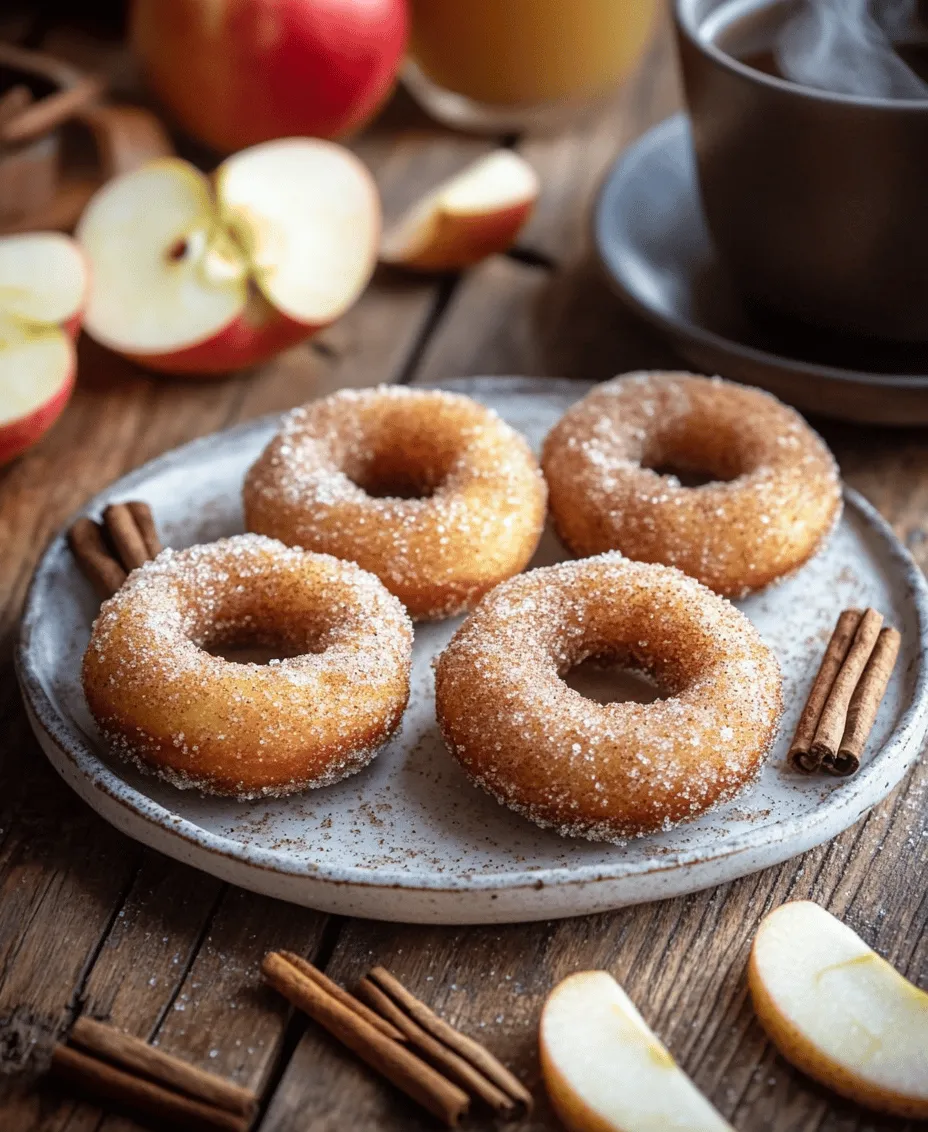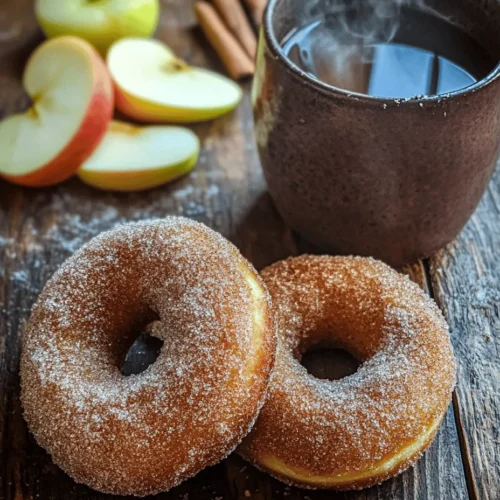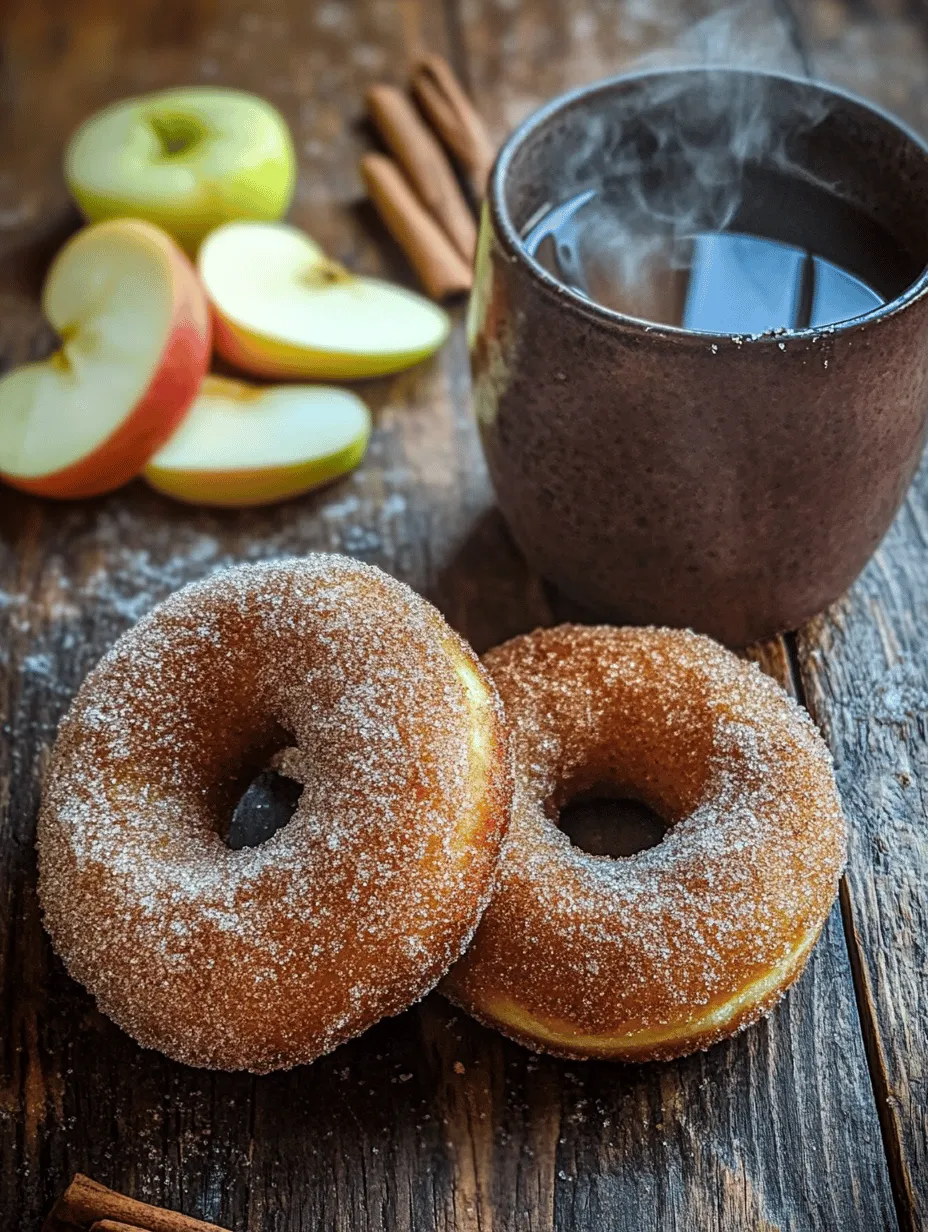Introduction
As the leaves begin to change and the air turns crisp, nothing embodies the spirit of fall quite like a warm, freshly baked apple cider donut. These delightful treats are a perfect fusion of sweetness, spice, and nostalgia, making them a staple at apple orchards and fall festivals. The combination of fragrant spices and the rich flavor of apple cider creates a comforting experience that transports you to a cozy autumn afternoon, even if you’re enjoying them in the comfort of your own kitchen.
Apple cider donuts are not only easy to make, but they also offer a delightful way to celebrate the season. The appeal of these donuts lies in their moist texture and the balance of flavors that come from using quality ingredients. Whether you’re looking to impress guests at a fall gathering or simply indulge yourself, this comprehensive guide will walk you through the process of crafting irresistible apple cider donuts from scratch. From understanding the key ingredients that contribute to their unique taste to mastering the baking process, you’ll be equipped to bring the warmth of autumn into your kitchen.
Understanding the Ingredients
Creating the perfect apple cider donut starts with understanding the ingredients that make them so special. Each component plays a crucial role in achieving that coveted flavor and texture. Let’s explore these key ingredients in more detail.
The Role of Apple Cider
Apple cider is the star of the show when it comes to flavor. This unfiltered juice, made from freshly pressed apples, is a concentrated source of apple flavor and sweetness. But not all apple cider is created equal. To ensure you get the best flavor in your donuts, opt for high-quality, fresh apple cider.
How Reducing Apple Cider Enhances Flavor
One of the secrets to intensifying the flavor of your apple cider donuts lies in the technique of reducing apple cider. By simmering the cider over low heat, you allow the water content to evaporate, concentrating the natural sugars and flavors. This process transforms the cider into a rich, syrupy liquid that infuses your donuts with a deep apple flavor.
The Importance of Quality Apple Cider
When selecting apple cider for your recipe, look for a product that is labeled as “fresh” or “raw.” These ciders often have a more robust flavor profile compared to processed varieties. Ideally, you should choose cider that is made from a mix of sweet and tart apples, as this will create a more complex taste in your final product. The quality of your apple cider can make a significant difference in the final outcome of your donuts, so it’s worth sourcing the best you can find.
Applesauce: A Moisture Secret
In addition to apple cider, unsweetened applesauce is another key ingredient in apple cider donuts. This versatile component serves multiple purposes in baking.
Benefits of Using Unsweetened Applesauce
Using unsweetened applesauce not only adds moisture to the donuts but also contributes natural sweetness without the need for additional sugar. This is particularly helpful if you want to keep your donuts on the healthier side. The applesauce acts as a binding agent, helping to hold the ingredients together while also preventing the donuts from becoming dry.
How Applesauce Contributes to Texture
The texture of your apple cider donuts can be significantly improved by incorporating applesauce. It creates a tender crumb that is soft and inviting. When combined with other wet ingredients, the applesauce ensures that every bite is bursting with flavor and moisture, making your donuts irresistible.
The Sweet Balance: Granulated and Brown Sugar
When it comes to sweetening your apple cider donuts, a combination of granulated sugar and brown sugar is often used. Understanding the differences between these two sugars can enhance your baking skills.
Differences Between Granulated and Brown Sugar
Granulated sugar is a staple in baking and provides a straightforward sweetness. In contrast, brown sugar contains molasses, which adds moisture and a hint of caramel flavor. This flavor complexity enhances the overall taste of your donuts, contributing to their rich, autumnal profile.
The Effects of Sugar on Flavor and Texture
The combination of these sugars not only affects the sweetness of your donuts but also impacts their texture. Brown sugar helps to create a moist and chewy texture, while granulated sugar contributes to a slight crispness on the outside. This balance leads to a perfect donut that is both tender and satisfying.
The Power of Spices
No apple cider donut is complete without the warm spices that evoke the essence of fall. The right mix of spices can elevate your donuts from ordinary to extraordinary.
Importance of Cinnamon and Nutmeg in Flavor Profiles
Cinnamon and nutmeg are the quintessential spices used in apple cider donuts. Their warming flavors complement the sweetness of the apple cider and applesauce, creating a harmonious blend that is comforting and nostalgic. The aromatic qualities of cinnamon and nutmeg not only enhance the flavor but also fill your kitchen with an inviting fragrance as they bake.
How Spices Enhance the Autumnal Experience
The inclusion of spices in your recipe is not just about flavor; it’s also about evoking memories and feelings associated with the fall season. The warm, spicy aroma of cinnamon and nutmeg wafting through your home can transport you to cozy gatherings and crisp autumn days, making your baking experience all the more enjoyable.
The Science of Leavening Agents
To achieve the perfect rise in your apple cider donuts, understanding the role of leavening agents is crucial.
The Function of Baking Powder and Baking Soda
Baking powder and baking soda are both leavening agents that help your donuts rise and become light and fluffy. Baking soda is a base that reacts with acidic ingredients (like apple cider) to produce carbon dioxide, which creates bubbles in the batter. Baking powder, on the other hand, contains both an acid and a base, allowing it to work in a variety of recipes.
Importance of Salt in Baking
Salt is often an overlooked ingredient, but it plays an essential role in balancing flavors and enhancing the overall taste of your donuts. A small amount of salt can highlight the sweetness of the sugars and the warmth of the spices, bringing the entire flavor profile together.
Preparation Steps for Perfect Donuts
Now that we have a better understanding of the key ingredients, it’s time to dive into the preparation steps that will lead you to the perfect apple cider donuts. Follow these guidelines closely to ensure success in your baking endeavor.
Reducing Apple Cider: The First Step to Flavor
The first step to creating rich, flavorful apple cider donuts is reducing the apple cider. This process is straightforward yet essential for intensifying the flavor.
Techniques for Simmering Apple Cider
Begin by pouring your fresh apple cider into a saucepan. Heat it over medium heat and bring it to a gentle simmer. As the cider simmers, keep an eye on it to prevent it from boiling over. You want to maintain a steady simmer, allowing the water content to evaporate slowly.
Tips for Cooling Cider Efficiently
Once the cider has reduced to about half its original volume and has thickened to a syrupy consistency (this usually takes about 15-20 minutes), remove it from the heat. Let it cool completely before incorporating it into your donut batter. To speed up the cooling process, you can transfer the reduced cider to a shallow dish, which will help it cool evenly and quickly.
Prepping the Donut Pan
Before you start mixing your ingredients, it’s crucial to prepare your donut pan properly to ensure your donuts release easily after baking.
How to Properly Grease a Donut Pan
Most donut pans are non-stick, but it’s still a good idea to grease them lightly to prevent any sticking. Use a cooking spray or a pastry brush to apply a thin layer of oil or melted butter to each cavity of the pan. This will create a barrier that helps the donuts come out cleanly once they are baked.
Alternatives to Traditional Donut Pans
If you don’t have a donut pan, don’t worry! You can get creative with your baking. Consider using a muffin pan and filling it slightly less than you would for muffins; this will give you a similar result, albeit with a different shape. Alternatively, you can use a baking sheet and pipe the batter into donut shapes, although this method may require a bit more finesse.
Mixing Wet Ingredients
With your apple cider reduced and your pan prepared, it’s time to mix the wet ingredients. This stage is where the magic begins to happen as the flavors start to meld together.
Combining the Ingredients
In a large mixing bowl, combine the reduced apple cider, unsweetened applesauce, granulated sugar, and brown sugar. Whisk these ingredients together until they are well blended. The heat from the cider may help dissolve the sugars, making it easier to achieve a smooth mixture.
Adding Eggs and Vanilla
Next, beat a couple of eggs into the mixture, followed by a splash of vanilla extract. The eggs provide structure and richness, while the vanilla enhances the overall flavor, making your donuts even more enticing. Mix until everything is well incorporated and smooth.
This initial phase of mixing sets the foundation for your apple cider donuts, ensuring that each bite is packed with flavor and moisture. Stay tuned for the next steps, where we will explore how to combine the wet and dry ingredients to create the perfect batter and ultimately bake these delightful treats.

Ensuring a Smooth Mixture for Optimal Texture
To achieve the perfect texture for your apple cider donuts, it is essential to ensure that your mixture is smooth and well-combined. The process begins with the wet ingredients. Start by whisking together your apple cider, eggs, and melted butter in a large mixing bowl. This step is crucial as it ensures that the ingredients blend seamlessly, creating a cohesive batter.
The Significance of Whisking Thoroughly
Whisking is not just a step in the process; it’s a technique that can make or break the texture of your donuts. By whisking thoroughly, you incorporate air into the mixture, which helps to create a lighter, fluffier donut. Take your time with this step—aim for a smooth and homogenous mixture where the ingredients are fully integrated, and there are no lumps of flour or butter remaining.
Combining Dry Ingredients
Once your wet ingredients are well-mixed, it’s time to focus on the dry ingredients. In a separate bowl, combine the flour, baking powder, baking soda, salt, cinnamon, and nutmeg. This step is crucial, as it ensures that each dry ingredient is evenly distributed throughout the flour.
The Importance of Sifting for a Light Texture
Sifting your dry ingredients is a simple yet effective technique that you should not overlook. By sifting, you break up any clumps and aerate the flour, which contributes to a lighter texture in your finished donuts. It also helps to evenly distribute the leavening agents, ensuring that your donuts rise uniformly.
Understanding How Dry Ingredients Interact
Each dry ingredient plays a specific role in the final product. Flour provides structure, while baking powder and baking soda are responsible for the leavening. Salt enhances flavor, and spices like cinnamon and nutmeg contribute to the warm, inviting aroma and taste. Understanding these interactions is key to mastering your donut recipe.
Merging Wet and Dry Mixtures
Now that you have prepared both the wet and dry mixtures, it’s time to combine them. Begin by creating a well in the center of your dry ingredients, then pour in the wet mixture. This technique helps to minimize the amount of mixing required, which is crucial in preventing overmixing.
The Art of Folding Mixtures Without Overmixing
When combining the wet and dry ingredients, use a spatula or wooden spoon to gently fold them together. Folding is a technique that involves turning the mixture over itself rather than stirring vigorously. This method helps retain the air you’ve incorporated during whisking, contributing to a lighter donut. Stop mixing as soon as you see no dry flour; a few small lumps are perfectly acceptable.
Recognizing the Perfect Consistency of Batter
The ideal batter consistency for apple cider donuts should be thick but pourable. It should hold its shape but not be so dense that it becomes difficult to work with. If your batter is too thick, you can add a splash of apple cider to loosen it. Conversely, if it’s too runny, you may need to incorporate a bit more flour.
Baking the Donuts
Essential Tips for Achieving the Perfect Bake
With your batter ready, it’s time to bake those beautiful donuts. There are a few essential tips to keep in mind to ensure they turn out perfectly.
Proper Oven Temperature: Why It Matters
The temperature of your oven is critical when baking donuts. For apple cider donuts, preheat your oven to 350°F (175°C). This temperature allows the donuts to rise properly without burning. If your oven is too hot, the outside of the donuts may brown quickly while leaving the insides undercooked.
The Science Behind Baking at 350°F
Baking at 350°F is a sweet spot for many baked goods, including donuts. At this temperature, the heat penetrates the batter evenly, promoting a balanced rise and preventing the exterior from becoming too dark before the inside is fully cooked.
How to Check Your Oven’s Accuracy
Oven temperatures can fluctuate, so it’s wise to check the accuracy of your oven with an oven thermometer. If your oven runs hot, you may need to adjust the temperature down slightly to avoid overbaking your donuts.
Timing for Donut Perfection
Once your donuts are in the oven, timing is everything. Bake them for about 10-12 minutes, but keep a close eye on them, as baking times can vary based on your specific oven and the size of your donuts.
Knowing When Donuts Are Done Baking
To know when your donuts are ready, look for a golden-brown color on the tops. They should spring back when lightly pressed.
Utilizing the Toothpick Test Effectively
The toothpick test is a reliable method to determine doneness. Insert a toothpick into the center of a donut; if it comes out clean or with a few moist crumbs, the donuts are ready. If it comes out wet with batter, give them a few more minutes.
Cooling Techniques for the Best Texture
The cooling process is just as important as baking. Allow the donuts to cool in the pan for about 5 minutes before transferring them to a wire rack. This prevents them from becoming soggy by allowing steam to escape.
Best Practices for Cooling Donuts in the Pan
Cooling them in the pan briefly allows the structure to set, making it easier to remove them without breaking. After that, transfer them to a wire rack to cool completely. This ensures they maintain their texture and don’t become overly moist.
Avoiding Sogginess After Baking
To avoid sogginess, ensure that the donuts are not left in the pan for too long. If they sit too long, moisture can accumulate, leading to a less desirable texture.
Coating and Serving
Making Your Donuts Irresistible with the Perfect Finish
Once your donuts have cooled, it’s time for the final touch: coating them in a delightful cinnamon sugar mixture.
Creating the Cinnamon Sugar Coating
To create your cinnamon sugar coating, combine granulated sugar with ground cinnamon in a bowl. A good ratio to follow is 1 cup of sugar to 2 tablespoons of cinnamon. This blend delivers a sweet and spicy flavor that perfectly complements the apple cider in your donuts.
The Ideal Ratio of Sugar to Cinnamon
Adjust the sugar-to-cinnamon ratio based on your preference. If you enjoy a more pronounced cinnamon flavor, feel free to increase the cinnamon amount.
Techniques for Even Coating
To ensure an even coating, roll the warm donuts in the cinnamon sugar mixture while they are still slightly warm. This allows the sugar to adhere better, creating a beautiful finish. Make sure to coat all sides for maximum flavor.
Serving Suggestions
Apple cider donuts are best enjoyed fresh but can also be paired with a variety of beverages. They make an excellent accompaniment to a hot cup of coffee, tea, or even a glass of warm apple cider.
Pairing Ideas with Beverages Like Coffee or Cider
For a delightful experience, serve your apple cider donuts with freshly brewed coffee or spiced chai. The warm spices in both the donuts and the drinks create a harmonious flavor profile that enhances the overall tasting experience.
Creative Serving Options for Gatherings
If you’re hosting a gathering, consider serving your donuts on a tiered platter for a beautiful presentation. You can also drizzle them with a simple glaze made from powdered sugar and apple cider for an extra touch of sweetness.
Conclusion
Irresistible apple cider donuts are a delightful addition to any dessert table or cozy breakfast spread. With their warm spices and rich flavors, they embody the spirit of fall and are sure to please anyone who takes a bite. By following this comprehensive guide, you can master the art of making these delicious donuts at home, bringing joy to your table and warmth to your gatherings. Enjoy the process, savor each bite, and share the love of baking with friends and family.



